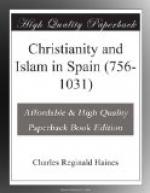Besides these within the walls, there were ten or twelve monasteries and churches in the immediate neighbourhood of Cordova: among them the monastery of St Christopher, the famous one of Tabanos, suppressed as above mentioned, in 854;[1] those of St Felix at Froniano, of St Martin at Royana, of the Virgin Mary at Cuteclara, of St Salvator at Pegnamellar; and the churches of SS. Justus and Pastor, and of St Sebastian.
We have given the names of these churches and monasteries[2] at or near Cordova, both to shew how numerous they were, and also because from one or other of them came nearly all the self-devoted martyrs, of whom we are about to consider the claims. Except in cases like that above-mentioned, the Christians were not allowed to build new churches,[3] but considering the diminution in the numbers of the Christians owing to the conquest, and the apostasy of a great many, this could not be reckoned a great hardship. Moreover the Christian churches, it was ordained, should be open to Moslems as well as Christians, though during the performance of mass it seems that they had to be kept closed. The Mosques were never to be polluted by the step of an infidel.[4]
[1] Dozy, ii. 162.
[2] Monasteries were established in Spain 150 years before the Saracen conquest. They mostly fared badly at the hands of the Arabs, in spite of the injunctions of the Khalif Abubeker (see Conde, i. 37, and Gibbon), but that of Lorban at Coimbra received a favourable charter in 734 (Fleury, v. 89; but Dunham, ii. 154, doubts the authenticity of the charter).
[3] Cp. the stipulation of Omar at the fall of Jerusalem.
[4] See Charter of Coimbra, apud Fleury, v. 89.
The religious ferment, which manifested itself so strongly at Cordova, did not extend to other parts of Spain. For instance, at Elvira, the cradle of Spanish Christianity, it was shortly after the Cordovan martyrdoms (in 864) that the mosque, founded in the year of the conquest, and left unbuilt for 150 years, was finally finished. What we hear about the Christians at Elvira at this time is not to their credit, their bishop, Samuel, being notorious as an evil liver.[1] It is in Cordova that the main interest at this period centres; and to Cordova we will for the present confine our attention.
There is abundant evidence to show that the party of enthusiasts, both those who offered themselves for martyrdom, and those who aided and abetted their more impulsive brethren, were a comparatively small body in the Church of Spain; and that their proceedings awakened little short of dismay in the minds of the more sensible portion of the Christian community, both in the Arab part of Spain, and perhaps in a less degree in the free North.[2] The chief leaders of the party of zealots—as far as we find mention of them—were Saul, bishop of Cordova (850-861), Eulogius, and Samson, abbot of the monastery of Pegnamellar; while Reccafredus, bishop of Seville, and Hostegesis of Malaga, were the prominent ecclesiastics on the other side.




